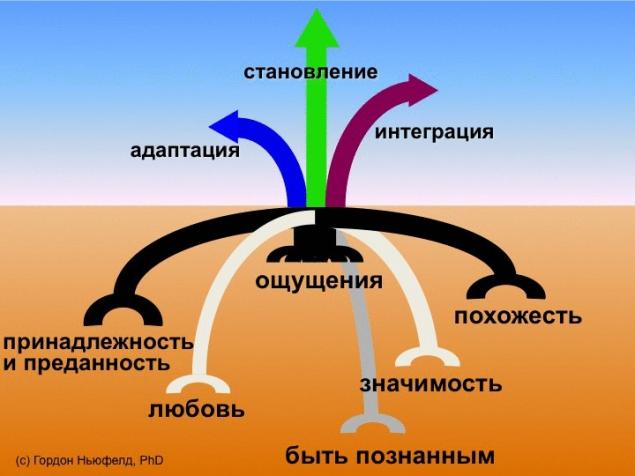671
Gordon Neufeld on attachment levels
Thirty six million seven thousand eighty four
The biggest discovery for human attachment is that for the development of the capacity for relationship takes years; it takes about six stages before reaching full depth. If conditions are favorable, each year's first six years of life should develop different ways to hold your attachment. However, I discovered that the ability to relationships it is never too late to develop. Early theories of attachment Bowlby, Lorenz and Harlow had missed this aspect of the depth of affection, since their theory was based primarily on observations of young primates and birds and babies.

Six levels of attachment in the model Neufeld I use the analogy with plants, to show how the child develops the capacity for relationship. We are usually more aware about is the process of maturation described above.(see the text of the pamphlet*) the Roots of attachment are hidden from view or at least from our consciousness. As a result, we do not have enough words to describe affection. My book “don't lose your children” is translated at the moment into 15 languages, and every language it was hard to find the words to describe the phenomenon of attachment. Historically, the wisdom of attachment was embedded in the customs and rituals, but when our culture collapses, we can go back to the roots only through words and awareness. I believe that this is the task of today's science – choose words that reflect reality and simultaneously find intuitive response.
Most plants can only take root in a variety of ways, so human beings can become attached in different ways. The deeper roots of attachment, the better they get to choose the right nutrition for growth and maturation.
The first stage of the affection is the feelings. The child seeks to be with those to whom he is attached: to touched him, seen him, heard, sensed his smell. This type of relationship is the basis of all attachment, but it is especially necessary when other ways to save the attachment has not yet developed. The fundamental human problem from the point of view of affection is the ability to endure separation, while maintaining a sense of relationship.
Modern electronic means of communication are so popular because they give instant response to the basic human problem – the physical separation. However, a technological solution is not the answer that nature intended, and expanding reach, we risk to prevent a real solution to this human dilemma, which is the fully developed ability to relationships. New research suggests that the virtual “proximity” not only permeates, but, moreover, substitute a deep personal relationship and prevents its appearance.
Another problem is that virtual proximity is that it pulls children from the audience in their adult life, replacing them with peers. The phenomenon of orientation at the same age actually preceded the technological revolution, paving the way for the current ubiquity of electronic means of communication. When children are focused on their peers, they prefer to spend time with them, not with adults who are responsible for them. Although orientation to peers is quite common in modern society, is the phenomenon of “aberrant” attachment is totally contrary to the conditions necessary for human growth and development, leading to massive developmental delay. This is exactly what our research finds, many modern children do not grow up with the growth. The epidemic of immaturity is spreading.
Further, the children tended to imitate, to impersonate, to portray those to whom they are attached. Children from one to two years understand the closeness as the similarity, not just physical contact. This dynamic allows us to “cast” the child in my own image without much effort. It is also the key to mastering it. It's very simple: like all creatures, we repeat the sounds for those to whom we are attached. A simple understanding of this, whether it is more common, would produce a revolution in education. The conventional wisdom today is that we are losing the war against illiteracy. Today teenagers have a more limited vocabulary than teenagers of the past. If you look through the lens of attachment, the reason becomes obvious: the teenagers of today are more often focused on their peers, not present in their adult life, than teenagers of previous generations. They imitate each other not only in speech, but also look like each other, dress alike, walk alike. The secret of literacy in this case was simple and effective: create a working attachment between students and teachers. For example, when I participated in the project of restoring the culture of the indigenous people in Canada (Haida), in order to resurrect the language, we have developed a program that creates children's attachment to adults who still spoke the indigenous language. Language recovered spontaneously.
If the attachment brings at least some fruits of two years the child begins to feel its otherness. Now nature needed to find another way to maintain attachment during physical separation and the sense of otherness. Ideally, by the third year of life the child begins to understand intimacy as belonging or feeling a part of the other or group. When this happens, usually also detected by another method of communication. To be close means to be on the same page with someone. Therefore, children begin to take the side of those to whom they are attached: to agree, to intercede, serve and obey. This is a manifestation of the instinct of devotion in our children, and without him we would not be able to fulfill the role of parents and teachers. No matter how much experience we have and knowledge, still just a growing attachment to the child allows us to take care of him.
If all goes well on the basic levels of affection, in the fourth year of life reveals the fourth way of preserving the relationship. By this time the child should understand that mum and dad are close with who/what you hold dear. In response, the child begins to try to it meant a lot to those to whom he is tied, trying to be special, to matter, to be meaningful to them. I painted this “root” attachment gray (see the illustration above* “Six levels of attachment in the model Newfield”), because this method is more sensitive to the insults and vulnerable. Affection always makes us vulnerable, but when we want to have for someone a value, deeply hurt us any sign that we care about. If the deep attachment is insecure, the “roots” of attachment remain superficial. The price for this is lower the ability to bind and define the necessary nutrition for growth and prosperity.
If all goes as it should, and the relationship can deepen without serious injury, in the fifth year of life revealed a surprising phenomenon. Of course, if the ability to relationships not growing properly, it may occur much later or, unfortunately, not happen ever. The limbic system – the emotional brain – “let go all brakes”, pushing the child to the very limits of emotional vulnerability. Easier to say, the child begins to give his heart to those to whom he is attached. We call this emotional intimacy. Sadly, many adults do not reached the capacity for such deep relationships. When we have our children's hearts, it allows them to maintain a sense of intimacy with us, if other means of attachment is not enough. This is also true in marriage and friendship. This emotional closeness significantly expands our reach, as it allows you to communicate with each other apart in different ways. However, in contrast to virtual proximity, this method requires favorable conditions and many years to develop.
When children become attached on an emotional level, they may wish to marry with a parent. No idea about the attachment, Freud interpreted this phenomenon from a sexual point of view and called it the Oedipal complex and Electra complex. A child's desire to join us in marriage is no more and no less than never with us not to leave, for the same reason and we're getting married. Point of attachment and desire to be together.
I am sure it was never envisioned that we will be dealing with children, whose hearts did not own. This desire for attachment through the heart not only gives the child the possibility of deep nourishment, it also provides us, adults, the environment in which we can raise children to her fullest potential. This is true also for the school system. We, the parents, with bated breath, waiting for the first couple of weeks of the school year: whether the child's teacher, whether the child to believe that he likes the teacher. This intuitive understanding is supported by research, namely that the relationship between student and teacher are the single most important determinant of academic performance and behavior of the student. If this simple truth listened, it would change our approach to education.
When the school system was still included within the boundaries of the village of the affections of the child, the Central relationship between teacher and student was cultivated in the society through rituals and customs. Teachers didn't need to know the secret of his success, because, for the most part, the culture itself took care of creating the attachment. Unfortunately, over the last few generations, our schools have gone beyond the village affection of the pupil – with catastrophic consequences for the problem of education. The main issue in education has always been that the extent to which teaching affects the child's learning. Despite significant improvements in the curriculum, pedagogy and technology, teaching gives less and less results in training students. Blame the loss of the relationship between students and teachers. Simply put, teachers need to seize the hearts of students to get access to their minds.
After the child gave heart to those who care, there should be a desire also to share with them all that is in his heart. If all goes as it should, the child will strive to be known and understood by those to whom he is tied. Before that, if affection had brought any fruit, the child will have formed a sense of self and inner world of experiences, seemingly hidden from view – a secret “me”. The result of the natural process of human development is a profound sense of separateness and isolation. For this child to feel close – so not to be a mystery to your loved ones and not have any secrets that could keep them apart. We call this psychological intimacy is a powerful feeling of unity and relationships arising from the feeling that you really know. Now the child can eat, in addition, he has a profound way to hold on to the affection, if all other methods fail. Also, this method of attachment frees children from stealth, allowing adults better care of them. Too many children today are a mystery to their parents. Unable to understand their children, such parents take to the reading of parenting books. Unfortunately, the secrets of parenthood is rarely revealed in books.
To summarize: children must be tied to responsible adults. It not only supports the child's vital feeling of connection, but also creates a psychological “umbilical cord” through which we can feed their children, and the psychological womb in which we can grow. Although the well-being of children and society depends on the extent to which maturation, attachment required for maturation, and hence should be the highest priority and main concern of a successful society.published
© Gordon Neufeld. from the new brochure “the keys to the well-being of children and adolescents.”
Source: alpha-parenting.ru/2015/03/02/gordon-nyufeld-ob-urovnyah-privyazannosti/
The biggest discovery for human attachment is that for the development of the capacity for relationship takes years; it takes about six stages before reaching full depth. If conditions are favorable, each year's first six years of life should develop different ways to hold your attachment. However, I discovered that the ability to relationships it is never too late to develop. Early theories of attachment Bowlby, Lorenz and Harlow had missed this aspect of the depth of affection, since their theory was based primarily on observations of young primates and birds and babies.

Six levels of attachment in the model Neufeld I use the analogy with plants, to show how the child develops the capacity for relationship. We are usually more aware about is the process of maturation described above.(see the text of the pamphlet*) the Roots of attachment are hidden from view or at least from our consciousness. As a result, we do not have enough words to describe affection. My book “don't lose your children” is translated at the moment into 15 languages, and every language it was hard to find the words to describe the phenomenon of attachment. Historically, the wisdom of attachment was embedded in the customs and rituals, but when our culture collapses, we can go back to the roots only through words and awareness. I believe that this is the task of today's science – choose words that reflect reality and simultaneously find intuitive response.
Most plants can only take root in a variety of ways, so human beings can become attached in different ways. The deeper roots of attachment, the better they get to choose the right nutrition for growth and maturation.
The first stage of the affection is the feelings. The child seeks to be with those to whom he is attached: to touched him, seen him, heard, sensed his smell. This type of relationship is the basis of all attachment, but it is especially necessary when other ways to save the attachment has not yet developed. The fundamental human problem from the point of view of affection is the ability to endure separation, while maintaining a sense of relationship.
Modern electronic means of communication are so popular because they give instant response to the basic human problem – the physical separation. However, a technological solution is not the answer that nature intended, and expanding reach, we risk to prevent a real solution to this human dilemma, which is the fully developed ability to relationships. New research suggests that the virtual “proximity” not only permeates, but, moreover, substitute a deep personal relationship and prevents its appearance.
Another problem is that virtual proximity is that it pulls children from the audience in their adult life, replacing them with peers. The phenomenon of orientation at the same age actually preceded the technological revolution, paving the way for the current ubiquity of electronic means of communication. When children are focused on their peers, they prefer to spend time with them, not with adults who are responsible for them. Although orientation to peers is quite common in modern society, is the phenomenon of “aberrant” attachment is totally contrary to the conditions necessary for human growth and development, leading to massive developmental delay. This is exactly what our research finds, many modern children do not grow up with the growth. The epidemic of immaturity is spreading.
Further, the children tended to imitate, to impersonate, to portray those to whom they are attached. Children from one to two years understand the closeness as the similarity, not just physical contact. This dynamic allows us to “cast” the child in my own image without much effort. It is also the key to mastering it. It's very simple: like all creatures, we repeat the sounds for those to whom we are attached. A simple understanding of this, whether it is more common, would produce a revolution in education. The conventional wisdom today is that we are losing the war against illiteracy. Today teenagers have a more limited vocabulary than teenagers of the past. If you look through the lens of attachment, the reason becomes obvious: the teenagers of today are more often focused on their peers, not present in their adult life, than teenagers of previous generations. They imitate each other not only in speech, but also look like each other, dress alike, walk alike. The secret of literacy in this case was simple and effective: create a working attachment between students and teachers. For example, when I participated in the project of restoring the culture of the indigenous people in Canada (Haida), in order to resurrect the language, we have developed a program that creates children's attachment to adults who still spoke the indigenous language. Language recovered spontaneously.
If the attachment brings at least some fruits of two years the child begins to feel its otherness. Now nature needed to find another way to maintain attachment during physical separation and the sense of otherness. Ideally, by the third year of life the child begins to understand intimacy as belonging or feeling a part of the other or group. When this happens, usually also detected by another method of communication. To be close means to be on the same page with someone. Therefore, children begin to take the side of those to whom they are attached: to agree, to intercede, serve and obey. This is a manifestation of the instinct of devotion in our children, and without him we would not be able to fulfill the role of parents and teachers. No matter how much experience we have and knowledge, still just a growing attachment to the child allows us to take care of him.
If all goes well on the basic levels of affection, in the fourth year of life reveals the fourth way of preserving the relationship. By this time the child should understand that mum and dad are close with who/what you hold dear. In response, the child begins to try to it meant a lot to those to whom he is tied, trying to be special, to matter, to be meaningful to them. I painted this “root” attachment gray (see the illustration above* “Six levels of attachment in the model Newfield”), because this method is more sensitive to the insults and vulnerable. Affection always makes us vulnerable, but when we want to have for someone a value, deeply hurt us any sign that we care about. If the deep attachment is insecure, the “roots” of attachment remain superficial. The price for this is lower the ability to bind and define the necessary nutrition for growth and prosperity.
If all goes as it should, and the relationship can deepen without serious injury, in the fifth year of life revealed a surprising phenomenon. Of course, if the ability to relationships not growing properly, it may occur much later or, unfortunately, not happen ever. The limbic system – the emotional brain – “let go all brakes”, pushing the child to the very limits of emotional vulnerability. Easier to say, the child begins to give his heart to those to whom he is attached. We call this emotional intimacy. Sadly, many adults do not reached the capacity for such deep relationships. When we have our children's hearts, it allows them to maintain a sense of intimacy with us, if other means of attachment is not enough. This is also true in marriage and friendship. This emotional closeness significantly expands our reach, as it allows you to communicate with each other apart in different ways. However, in contrast to virtual proximity, this method requires favorable conditions and many years to develop.
When children become attached on an emotional level, they may wish to marry with a parent. No idea about the attachment, Freud interpreted this phenomenon from a sexual point of view and called it the Oedipal complex and Electra complex. A child's desire to join us in marriage is no more and no less than never with us not to leave, for the same reason and we're getting married. Point of attachment and desire to be together.
I am sure it was never envisioned that we will be dealing with children, whose hearts did not own. This desire for attachment through the heart not only gives the child the possibility of deep nourishment, it also provides us, adults, the environment in which we can raise children to her fullest potential. This is true also for the school system. We, the parents, with bated breath, waiting for the first couple of weeks of the school year: whether the child's teacher, whether the child to believe that he likes the teacher. This intuitive understanding is supported by research, namely that the relationship between student and teacher are the single most important determinant of academic performance and behavior of the student. If this simple truth listened, it would change our approach to education.
When the school system was still included within the boundaries of the village of the affections of the child, the Central relationship between teacher and student was cultivated in the society through rituals and customs. Teachers didn't need to know the secret of his success, because, for the most part, the culture itself took care of creating the attachment. Unfortunately, over the last few generations, our schools have gone beyond the village affection of the pupil – with catastrophic consequences for the problem of education. The main issue in education has always been that the extent to which teaching affects the child's learning. Despite significant improvements in the curriculum, pedagogy and technology, teaching gives less and less results in training students. Blame the loss of the relationship between students and teachers. Simply put, teachers need to seize the hearts of students to get access to their minds.
After the child gave heart to those who care, there should be a desire also to share with them all that is in his heart. If all goes as it should, the child will strive to be known and understood by those to whom he is tied. Before that, if affection had brought any fruit, the child will have formed a sense of self and inner world of experiences, seemingly hidden from view – a secret “me”. The result of the natural process of human development is a profound sense of separateness and isolation. For this child to feel close – so not to be a mystery to your loved ones and not have any secrets that could keep them apart. We call this psychological intimacy is a powerful feeling of unity and relationships arising from the feeling that you really know. Now the child can eat, in addition, he has a profound way to hold on to the affection, if all other methods fail. Also, this method of attachment frees children from stealth, allowing adults better care of them. Too many children today are a mystery to their parents. Unable to understand their children, such parents take to the reading of parenting books. Unfortunately, the secrets of parenthood is rarely revealed in books.
To summarize: children must be tied to responsible adults. It not only supports the child's vital feeling of connection, but also creates a psychological “umbilical cord” through which we can feed their children, and the psychological womb in which we can grow. Although the well-being of children and society depends on the extent to which maturation, attachment required for maturation, and hence should be the highest priority and main concern of a successful society.published
© Gordon Neufeld. from the new brochure “the keys to the well-being of children and adolescents.”
Source: alpha-parenting.ru/2015/03/02/gordon-nyufeld-ob-urovnyah-privyazannosti/
Programming the universe: from the sexual revolution to the quantum computer
How to get rid of cellulite: what to eat, what are the procedures to go and what exercises to do























